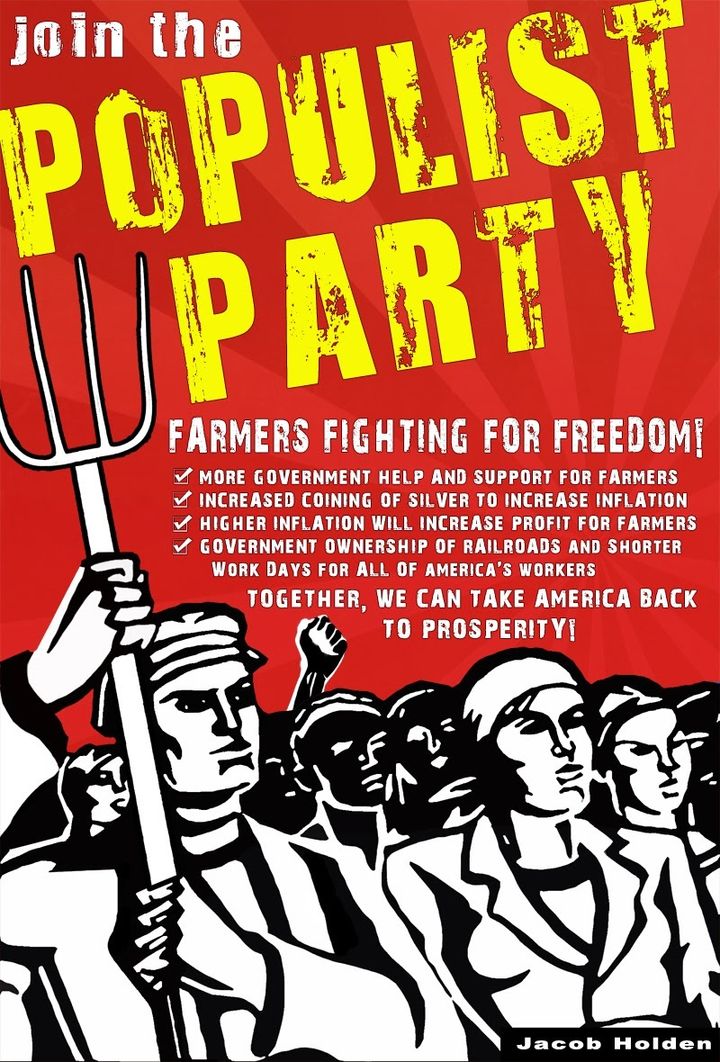
When someone asks a politically informed person in 21st-century America what the most left-leaning states in the union are, the answers spring readily to mind; Massachusetts, Vermont, California, New York. Ask that same question to a politically informed person one hundred years ago or more, and the answers they might give might shock our hypothetical time traveling political junkie. They might give an answer like Wyoming, the first state to give women the right to vote. Or they might pick Oklahoma, where in 1912 Socialist Presidential candidate Eugene Debs received a stunning 16% of the vote, more than triple his national total. The great progressive reform movement that swept America in the 20th century was not born in the corridors of Harvard University, it was born in the silver mines of Colorado and Nevada and on the windswept plains of the American west. The sad flipside to this story is that these states became ground zero for the decline and fall of American liberalism, and are now seen as hopeless bastions of the far right, the heart of “flyover country.” American liberals and progressives are wrong to write off these regions that were once the most fertile ground for their ideas. Indeed, there are already, in those places in the country seemingly the most devoid of hope, the signs that a true, bold progressive movement could take root in those places once again.
Author Thomas Frank’s book What’s The Matter With Kansas examined this phenomenon; the phenomenon of how a state now written off as the hardest of the hard right had a tradition of progressivism that recent decades not only was reversed politically, but was erased from political history. Pundits and political “experts” on both sides of the mainstream media act as if the current political state of affairs in states like Kansas, Montana, and others being “red” states has always been and will always be forever. But a closer examination of history shows that they are wrong.
This progressive turn in the American west began in the 1890s, a period in American history that our own is coming to resemble more and more. Robber barons, rampant corporate greed, and economic exploitation created massive inequalities and disparities between the top one percent of the population and the rest of the country (sound familiar?). The Republican Party still retained vestiges of the radical spirit that had animated it during the Civil War and Reconstruction, but by the 1890s it was well on its way to becoming the wholly owned subsidiary of business interests that it would be in the 20th century. The establishment of the Democratic Party was not much different, with the party being dominated in the south by the racist, reactionary Dixiecrats who at this time were instituting the Jim Crow laws, and in the north by the conservative Bourbon Democrats who largely agreed with their GOP counterparts on economic issues. Yet little did they expect that on the newly tamed frontier of the American West, a political rebellion against their joint rule was underway, a rebellion that took its shape alternately in the form of third party movements and progressives attempting to reshape the main parties in their image.
The election of 1892 heralded the start of a political groundswell that would continue on for decades. If you go to the Wikipedia page for this election, a rare third color is visible amidst the red and blue of the map- the green of the Populist Party. For the coalition of miners, farmers and railroad workers disaffected by the excesses of the Gilded Age and finding their plight largely ignored by both the Republicans and the Bourbon Democrats, the Populist Party represented a revolt against the system. Defying the massive structural obstacles to third party representation inherent in the American political system that persist to this day, the Populists not only captured nine percent of the popular vote, but also carved out a slice of green amidst the red and blue of that year’s electoral map- taking the Western and Plains states of Nevada, Idaho, Colorado, Kansas and North Dakota.
Though the Populist Party itself never again had such a showing in Presidential elections, the 1892 results nevertheless represented a political revolution that would echo through the following decades, particularly in those Western states. Beginning with the 1896 election, the Democrats largely absorbed the Populists’ message and constituency into their own platform; in three out of the next four elections the party would nominate William Jennings Bryan, a progressive firebrand known as “The Great Commoner.” Although Bryan would never win the White House in any of those elections, he began the process of reshaping the Democratic Party into something at least resembling a vehicle for representing working people’s interests.
The groundwork laid by Bryan’s reshaping of the party eventually paid off in these regions during the era of the New Deal coalition, both on the Presidential level as well as downballot. FDR and Truman dominated the Western states in every election from 1932 to 1948, as did LBJ in his 1964 landslide. Montana senator Mike Mansfield, the Democratic senate majority leader in the 1960s, was instrumental in helping LBJ pass the Great Society legislation including the Civil Rights and Voting Rights Act. Outspoken liberal Frank Church represented the state of Idaho for over twenty years in the Senate. So what happened over the past forty years to turn these states that had once been at the forefront of progressivism so deep red?
An easy answer is to point to Ronald Reagan, to say that he flipped many long-time white New Deal Democrats with appeals to racial and cultural resentment against liberal coastal elites. However, outside of the South studies of voting patterns among blue-collar whites show that the Republicans actually made few gains amongst this demographic. What happened instead was that voter turnout across the heartlands of America, both in the Mountain West and the Plains states such as Kansas and Nebraska, trended significantly down after the 1976 election, when the nomination of center-right leaning Democrat Jimmy Carter signaled the beginning of a long rightward shift in the party. At the same time as Democrats retreated from economic progressivism, Reagan and his successors (with the help of some center-right Democrats) unleashed a wave of corporate-friendly policies such as deregulation and union busting that crushed the organizing ability of labor and small farmers that had been the backbone of the New Deal coalition. On social issues, the restrictive GOP laws that made it harder for African-Americans in the south proved just as detrimental to Native Americans in the west, a crucial left-leaning voting bloc. The effect of all this was that by 2004, the places that had powered the progressive revolution were submerged by a Republican wave, as George W. Bush won every state between the Pacific coast and Minnesota.
In spite of all of this, however, there are signs of hope for the left in these states. Nevada, Colorado and New Mexico have swung back to the Democrats since 2008. Even in the more deep red states in these areas, there are cracks in the GOP’s armor there. Even though they fell short in congressional special elections, populist Democratic candidates Rob Quist of Montana and James Thompson of Kansas got some of the best congressional results the party has received there in decades. In the 2016 primaries, Bernie Sanders had some of his best results in deep red western states, mobilizing young people to a nearly unprecedented degree. Breaking Republican domination of America’s heartland will not be easy for progressives. It will require a combination of robust economic policies that give people real hope in the face of massive inequality, together with ensuring that all minorities have their rights to vote protected. Only then can Democrats bring some life back into the parts of the country that for them are their biggest ghost towns.
